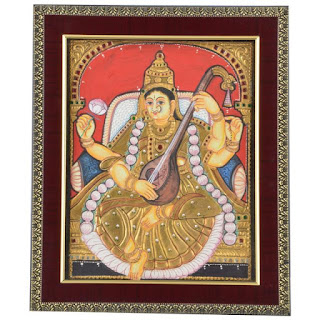Tanjore painting is a famous type of work of art that began in South India. These paintings have been well known from the sixteenth century and have advanced under the rule of the Chola rulers and are popular for its utilization of gold. At the point when the Marathas attacked Tanjore in Tamil Nadu numerous painters and specialists moved here and under their lead, this fine art prospered.
This type of painting is recognized by its utilization of gold and semi-valuable or valuable stones which is utilized to complement the outline.
Each painting recounts a story, more often than not rotating around Hindu divine beings, Goddesses or Saints.
In long time past days, Tanjore paintings were put in dull sanctuary places of worship by rulers. In a diminish put, the gold used to upgrade the painting.
 How are Tanjore paintings made?
How are Tanjore paintings made? Tanjore paintings are totally handcrafted and don't utilize any hardware. To make a Tanjore painting, an outline is first made on a material. This material is stuck on a wooden base, truly produced using the jackfruit tree. Today, plywood is utilized as an option. The canvas is equitably covered with Limestone or French chalk and a coupling medium. When dry, the portray is sketched out with dim darker or dark paint and painted utilizing splendid hues. These paintings have complex brush strokes and elegant figures. The gold adds life and profundity to the painting.
Between 2nd century B.C. and 7th century A.D., gold in these paintings helped inspire a feeling of devotion.
In olden days, vegetable or mineral dyes were used in the painting. The colors used were specific to different segments of the painting.
For example:
1. Backgrounds were usually red or green.
2. Lord Vishnu was colored blue and Lord Nataraja was painted white
3. The color yellow was used to paint Goddesses
4. The sky was painted blue or black depending on the story
5. The clothing and ornaments adorned by Gods and Goddesses were made of pure gold.
Gold, gemstones, pearls, glass dots, and valuable stones are embellished over the painting. This gave the paintings a three-dimensional impact. Normally, gold foils are utilized as a part of these paintings. Once in a while unadulterated gold drain or tidy is utilized also. The utilization of unadulterated gold makes the painting a breathtaking visual treat. Since gold was generally utilized, these paintings were viewed as a fortune. The sparkle of these paintings goes on for 80-100 years, as unadulterated gold never blurs.
There are many Tanjore paintings that you can choose from – the Saraswati Tanjore Painting, Krishna Tanjore painting and many more. The most-loved theme by Tanjore painters has been the image of baby Krishna, sitting on his golden throne with a pot of butter in his hands. He is elaborately bejeweled and the painting features gold in his jewellery, clothing and the throne.



